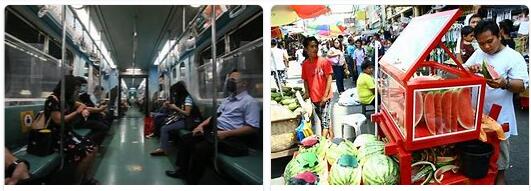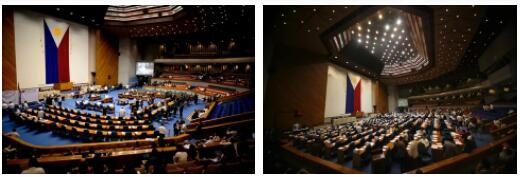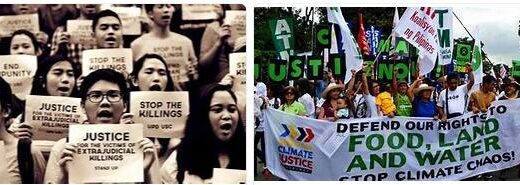Philippines Economic Sectors
ECONOMY: AGRICULTURE, LIVESTOCK AND FISHING
Agriculture affects more than a third of the active population and supplies the main export products; has favorable environments suitable for various crops. The agrarian reforms that have taken place over time have attempted to subvert the land structure based on land ownership, a legacy of the Spanish colonial past, which is holding back the sector. The resistance of the large owners but also of the peasants, who find the reform measures insufficient, have not allowed a real change in the situation. Most of the arable land is destined for rice cultivation, a traditional economic activity of the country, widespread almost everywhere but which finds its best area in the central plains of Luzon, N of Manila. The considerable production was possible thanks also to the introduction of improved rice varieties, which however require the use of expensive fertilizers as well as causing damage to the environment. The second most important cereal is maize, introduced by the Spaniards and particularly widespread in the Cagayan valley and in the northern section of Mindanao. Other relevant food products are bananas, of which the country is one of the largest producers in the world, cassava, vegetables and various types of fruit, including pineapple, mangoes and citrus fruits. Among the industrial crops, the first place is held by sugar cane, also grown in large plantations with modern equipment, despite the fact that production has undergone a significant downsizing since the 1970s. The coconut palm with its derivatives is widespread. It is mainly present in the Luzon island and supplies large quantities of oil, which is typically the first item of export. Secondary oil cultivation is that of peanuts. Various textile plants are also grown, including the so-called Manila hemp or abaca, agaves (sisalana and maguey) and ramie; tobacco is highly prized, widely consumed locally, which has its most suitable area in the Cagayan valley and in general in Luzon, as well as in the western part of the island of Mindanao. Of considerable importance are the cultivation of coffee and, to a lesser extent, cocoa, for which the country is one of the main producers on the continent. Forestry activities also play an important economic role: Philippine mahogany is widely requested by foreign markets, while bamboo is used for various internal uses.; good consistency has the production of natural rubber. Woods and forests, which covered a large portion of the land area, are less and less extensive: excessive deforestation has already led to at least partially suspend the export of timber. The woodland was also heavily damaged by fires in 1998 and 2002. § Livestock farming, given also the very limited extension of grassland and pasture areas, has long played a marginal role in the country’s economy and has begun to develop only starting from the 1960s. The sector includes buffaloes, typically Asian animals, while cattle were introduced by the Spaniards; quite numerous are the pigs, not present in the areas populated by Muslims. It is the poultry farming to represent the first voice of breeding. § Fishing is widespread, but limited by heavy coastal pollution and destructive methods of exploitation. Consistent is the collection of sponges, practiced essentially in the southern waters. Aquaculture, introduced in the 1980s, supplies shrimp for export in particular.
ECONOMY: INDUSTRY AND MINERAL RESOURCES
The industries essentially concern the processing of local agricultural products and therefore include sugar refineries, rice husking and polishing plants, oil mills, tobacco factories, breweries, etc. The development of the textile and chemical industry, in particular for nitrogen fertilizers, began in the 1950s. to meet internal needs. The diversification of the sector led to the birth of the paper industry, as well as the electronics sector. There are also several cement factories and some petrochemical plants, small tire factories, a steel and an automotive complex. The implants are mostly located on the Luzon Island (near Manila) but the relocation projects have led to the construction of industrial complexes also in the other large regions. § The resources of the subsoil are various and for some minerals not negligible; the country has in fact gold deposits (already mined in very significant quantities at the time of the Spaniards) of which it is one of the major Asian producers, silver, manganese, nickel, iron, chromium and copper. The minerals are sent for export (mainly to the US and Japan) and are subject to market fluctuations. The country is not self-sufficient from an energy point of view: the island of Cebu supplies modest quantities of coal and the oil fields, extracted since 1979 off the island of Palawan, are not yet adequately exploited. The use of
ECONOMY: TRADE, TOURISM AND COMMUNICATIONS
According to Cheeroutdoor, international trade has historically been dominated by the United States and Japan, while smaller market shares mostly concern other Asian countries; the country mainly exports electrical and electronic material, machinery (office machines, computers, vehicle parts, radio and television), clothing, copra oil, copper, bananas and fish, while it imports electronic tools, fuels, machinery and means of transport, plastic; the trade balance is passive; tourism revenues are good despite the destabilizing political events and infrastructural deficiencies. Main tourist destinations are the UNESCO World Heritage Sites and the island of Boracay but the government’s intent is to enhance the attractiveness of new locations. § The communications problem is one of the most serious for the Philippines, above all due to the territorial fragmentation and the general mountainousness of the islands. For inter-island transport, both of goods and passengers, maritime services still play a prominent role; the airlines, managed by PAL (Philippines Airlines), which also carries out services with numerous countries in Asia and Europe, as well as with the United States and Australia, are showing a moderate development. The Philippines has over 80 airports, the most efficient of which are the international airports of Manila and Cebu; the capital is also the apex of maritime communications, both internal and international, but active ports are also those of Cebu, Iloilo, Davao, Batangas and Zamboanga (between small and large, the Philippines have over 500 ports). The train service is lacking and practically only covers the islands of Luzon and Panay. More extensive, even if it is also lacking, is the road system, which has approx. 200,000 km of roads, of which only a minimal part is asphalted.



